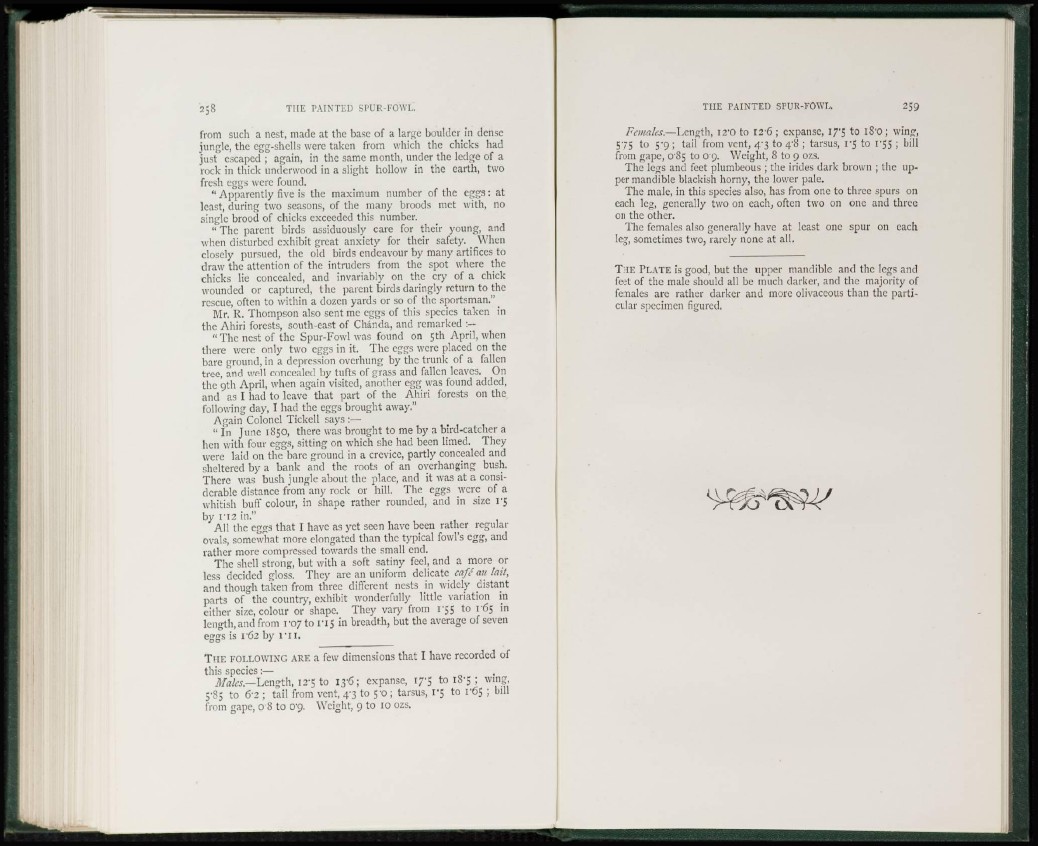
from such a nest, made at the base of a large boulder in dense
jungle, the egg-shells were taken from which the chicks had
just escaped ; again, in the same month, under the ledge of a
rock in thick underwood in a slight hollow in the earth, two
fresh eggs were found.
" Apparently five is the maximum number of the eggs : at
least, during two seasons, of the many broods met with, no
single brood of chicks exceeded this number.
" The parent birds assiduously care for their young, and
when disturbed exhibit great anxiety for their safety. When
closely pursued, the old birds endeavour by many artifices to
draw the attention of the intruders from the spot where the
chicks lie concealed, and invariably on the cry of a chick
wounded or captured, the parent birds daringly return to the
rescue, often to within a dozen yards or so of the sportsman."
Mr. R. Thompson also sent me eggs of this species taken in
the Ahiri forests, south-east of Chanda, and remarked :—
" T h e nest of the Spur-Fowl was found on 5th April, when
there were only two eggs in it. The eggs were placed on the
bare ground, in a depression overhung by the trunk of a fallen
tree, and well concealed by tufts of grass and fallen leaves. On
the gth April, when again visited, another egg was found added,
and as I had to leave that part of the Ahiri forests on the
following day, I had the eggs brought away."
Again Colonel Tickell says :—
" In June 1850, there was brought to me by a bird-catcher a
hen with four eggs, sitting on which she had been limed. They
were laid on the bare ground in a crevice, partly concealed and
sheltered by a bank and the roots of an overhanging bush.
There was bush jungle about the place, and it was at a considerable
distance from any rock or hill. The eggs were of a
whitish buff colour, in shape rather rounded, and in size 1*5
by r i 2 in."
All the eggs that I have as yet seen have been rather regular
ovals, somewhat more elongated than the typical fowl's egg, and
rather more compressed towards the small end.
The shell strong, but with a soft satiny feci, and a more or
less decided gloss. They are an uniform delicate cafe ait hit,
and though taken from three different nests in widely distant
parts of the country, exhibit wonderfully little variation in
either size, colour or shape. They vary from 1-55 to 165 in
length, and from i'07to 1*15 in breadth, but the average of seven
eggs is 1G2 by I ' l l,
T H E FOLLOWING ARE a few dimensions that I have recorded of
this species :—
Males.—Length, 12'5 to I3'6; expanse, I7'5 to IS'5 ; wing,
5-85 to 6'2 ; tail from vent, 4-3 to 50 ; tarsus, 1-5 to 1-65 ; bill
from gape, 08 to 0'9. Weight, 9 to 10 ozs.
Females.—Length, 12-0 to 126 ; expanse, I7'5 to iS'O; wing,
575 to 5-9 ; tail from vent, 4-3 to 4'8 ; tarsus, r j to 1*55 ; bill
from gape, 085 to 09. Weight, 8 to 9 ozs.
The legs and feet plumbeous ; the irides dark brown ; the upper
mandible blackish horny, the lower pale.
The male, in this species also, has from one to three spurs on
each leg, generally two on each, often two on one and three
on the other.
The females also generally have at least one spur on each
leg, sometimes two, rarely none at all.
T H E PLATE is good, but the upper mandible and the legs and
feet of the male should all be much darker, and the majority of
females are rather darker and more olivaceous than the particular
specimen figured.